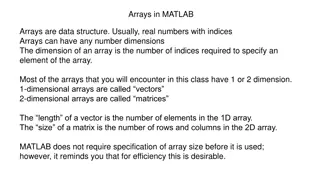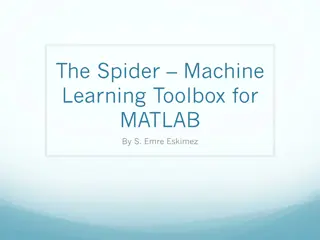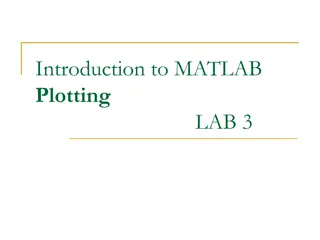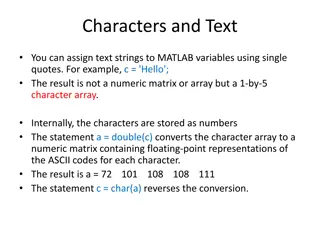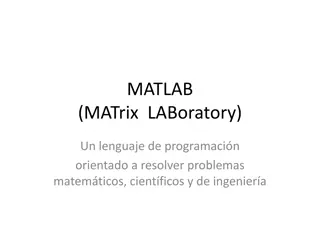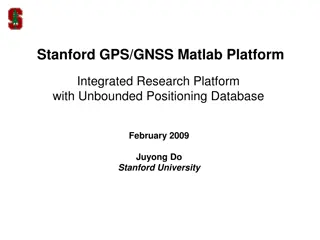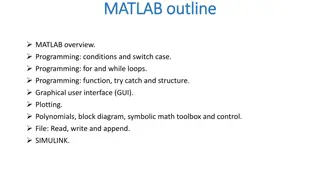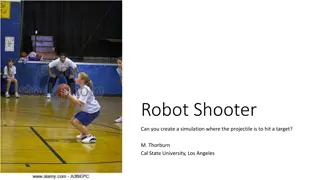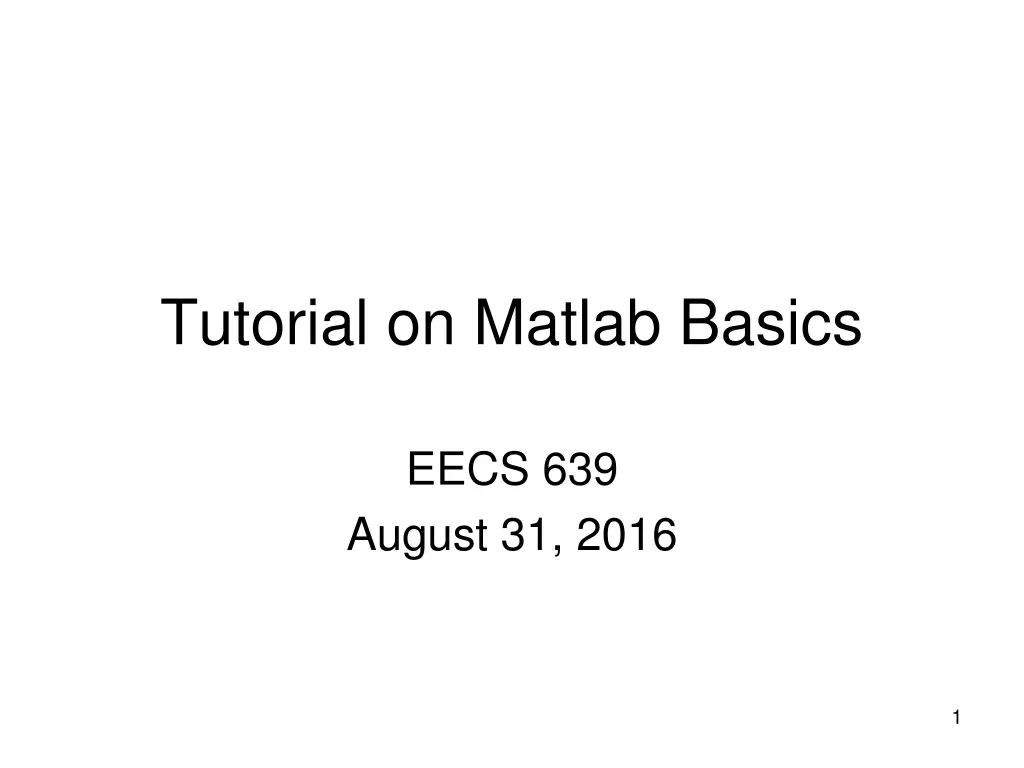
Mastering Matlab Basics: Essential Tips and Commands
Get started with Matlab by learning the basics including how to access Matlab, get help, understand workspace, use basic commands, manipulate numbers, and work with arrays and matrices. This tutorial covers key functionalities to help you become proficient in Matlab.
Download Presentation

Please find below an Image/Link to download the presentation.
The content on the website is provided AS IS for your information and personal use only. It may not be sold, licensed, or shared on other websites without obtaining consent from the author. If you encounter any issues during the download, it is possible that the publisher has removed the file from their server.
You are allowed to download the files provided on this website for personal or commercial use, subject to the condition that they are used lawfully. All files are the property of their respective owners.
The content on the website is provided AS IS for your information and personal use only. It may not be sold, licensed, or shared on other websites without obtaining consent from the author.
E N D
Presentation Transcript
Tutorial on Matlab Basics EECS 639 August 31, 2016 1
Matlab Basics To start Matlab: Select MATLAB on the menu (if using Windows). Type matlab on the command line (if using Linux). 2
Getting Help and Looking Up Functions To get help on a function type help function_name , e.g., help plot . To find a topic, type lookfor topic , e.g., lookfor matrix 3
Matlabs Workspace who, whos current workspace vars. save save workspace vars to *.mat file. load load variables from *.mat file. clear all clear workspace vars. close all close all figures clc clear screen clf clear figure 4
Basic Commands % used to denote a comment ; suppresses display of value (when placed at end of a statement) ... continues the statement on next line eps machine epsilon inf infinity NaN not-a number, e.g., 0/0. 5
Numbers To change format of numbers: format long, format short, etc. See help format . Mathematical functions: sqrt(x), exp(x), cos(x), sin(x), sum(x), etc. Operations: +, -, *, / Constants: pi, exp(1), etc. 6
Arrays and Matrices v = [-2 3 0 4.5 -1.5]; % length 5 row v = v ; v(1); v(2:4); v([3,5]); v=[4:-1:2]; a=1:3; b=2:3; c=[a b]; c = [1 2 3 2 3]; % transposes v. % first element of v. % entries 2-4 of v. % returns entries 3 & 5. % same as v=[4 3 2]; vector. 7
Arrays and Matrices (2) x = linspace(-pi,pi,10); % creates 10 linearly-spaced elements from pi to pi. logspace is similar. A = [1 2 3; 4 5 6]; % creates 2x3 matrix A(1,2) % the element in row 1, column 2. A(:,2) % the second column. A(2,:) % the second row. 8
Arrays and Matrices (3) A+B, A-B, 2*A, A*B matrix subtraction, scalar multiplication, matrix multiplication A.*B % element-by-element mult. A % transpose of A (complex- conjugate transpose) det(A) % determinant of A % matrix addition, 9
Creating special matrices diag(v) diag(A) eye(n) zeros(m,n) % m-by-n zero matrix. ones(m,n) % m*n matrix with all ones. % change a vector v to a diagonal matrix. % get diagonal of A. % identity matrix of size n. 10
Logical Conditions ==, <, >, <=, >=, ~= (not equal), ~ (not) & (element-wise logical and), | (or) find( condition ) Return indices of A s elements that satisfies the condition. Example: A = [7 6 5; 4 3 2]; find ( A == 3 ); --> returns 5. 11
Solving Linear Equations A = [1 2 3; 2 5 3; 1 0 8]; b = [2; 1; 0]; x = inv(A)*b; % solves Ax=b if A is invertible. (Note: This is a BAD way to solve the equations!!! It s unstable and inefficient.) x = A\b; % solves Ax = b. (Note: This way is better, but we ll learn how to program methods to solve Ax=b.) Do NOT use either of these commands in your codes! 12
More matrix/vector operations length(v) size(A) rank(A) norm(A), norm(A,1), norm(A,inf) % determine 2-norm, 1-norm, and infinity-norm of A. norm(v) % compute vector 2-norm. % determine length of vector. % determine size of matrix. % determine rank of matrix. 13
For loops x = 0; for i=1:2:5 % start at 1, increment by 2 x = x+i; % end with 5. end This computes x = 0+1+3+5=9. 14
While loops x=7; while (x > = 0) x = x-2; end; This computes x = 7-2-2-2-2 = -1. 15
If statements if (x == 3) disp( The value of x is 3. ); elseif (x == 5) disp( The value of x is 5. ); else disp( The value of x is not 3 or 5. ); end; 16
Switch statement switch face case {1} disp( Rolled a 1 ); case {2} disp( Rolled a 2 ); otherwise disp( Rolled a number >= 3 ); end NOTE: Unlike C, ONLY the SWITCH statement between the matching case and the next case, otherwise, or end are executed. (So breaks are unnecessary.) 17
Break statements break terminates execution of for and while loops. For nested loops, it exits the innermost loop only. 18
Vectorization Because Matlab is an interpreted language, i.e., it is not compiled before execution, loops run slowly. Vectorized code runs faster in Matlab. Example: x=[1 2 3]; for i=1:3 Vectorized: x(i) = x(i)+5; VS. x = x+5; end; 19
Graphics x = linspace(-1,1,10); y = sin(x); plot(x,y); plot(x,y, k- ); % plots a black line hold on; figure; % plots y vs. x. % put several plots in the same figure window. % open new figure window. of y vs. x. 20
Graphics (2) subplot(m,n,1) % Makes an mxn array for plots. Will place plot in 1st position. X Here m = 2 and n = 3. 21
Graphics (3) plot3(x,y,z) % plot 2D function. mesh(x_ax,y_ax,z_mat) surface plot. contour(z_mat) contour plot of z. axis([xmin xmax ymin ymax]) change axes title( My title ); - add title to figure; xlabel, ylabel label axes. legend add key to figure. 22
File Input/Output fid = fopen( in.dat , rt ); file for reading. v = fscanf(fid, %lg ,10); doubles from the text file. fclose(fid); % close the file. help textread; help fprintf; % open text % read 10 % formatted read. % formatted write. 26
Example Data File Sally Type1 12.34 45 Yes Joe Type2 23.54 60 No Bill Type1 34.90 12 No 27
Read Entire Dataset fid = fopen( mydata.dat , r ); % open file for reading. % Read-in data from mydata.dat. [names,types,x,y,answer] = textread(fid, %s%s%f%d%s ); fclose(fid); % close file. 28
Read Partial Dataset fid = fopen( mydata.dat , r ); % open file for reading. % Read-in first column of data from mydata.dat. [names] = textread(fid, %s %*s %*f %*d %*s ); fclose(fid); % close file. 29
Read 1 Line of Data fid = fopen( mydata.dat , r ); % open file % Read-in one line of data corresponding % to Joe s entry. [name,type,x,y,answer] = textread(fid, %s%s%f%d%s ,1, headerlines ,1); fclose(fid); % close file. % for reading. 30
Writing formatted data. % open file for writing. fid = fopen( out.txt , w ); % Write out Joe s info to file. fprintf(fid, %s %s %f %d %s\n ,name,type,x,y,answer); fclose(fid); % close the file. 31
Keeping a record To keep a record of your session, use the diary command: diary filename x = 3 diary off This will keep a diary called filename showing the value of x (your work for this session). 32
Timing Use tic, toc to determine the running time of an algorithm as follows: tic commands toc This will give the elapsed time. 33
Scripts and Functions Two kinds of M-files: - Scripts, which do not accept input arguments or return output arguments. They operate on data in the workspace. - Functions, which can accept input arguments and return output arguments. Internal variables are local to the function. 34
M-file functions function [area,circum] = circle(r) % [area, circum] = circle(r) returns the % area and circumference of a circle % with radius r. area = pi*r^2; circum = 2*pi*r; Save function in circle.m. 35
M-file scripts r = 7; [area,circum] = circle(r); % call our circle function. disp([ The area of a circle having radius num2str(r) is num2str(area)]); Save the file as myscript.m. 36
Tutorial sources http://docplayer.net/15715694- Introduction-to-matlab-basics-reference- from-azernikov-sergei-mesergei-tx- technion-ac-il.html Tutorial by Azernikov Sergei. 37
Interactive Example (1) Write a Matlab program to compute the following sum 1/i2, for i=1, 2, , 10 two different ways: 1. 1/1+1/4+ +1/100 2. 1/100+1/81+ +1/1. 38
Solution % Forward summation forwardsum = 0; for i=1:10 forwardsum = forwardsum+1/(i^2); end; % Backward summation backwardsum = 0; for i=10:-1:1 backwardsum = backwardsum+1/(i^2); end; 39
Interactive Example (2) Write a Matlab function to multiply two n-by-n matrices A and B. (Do not use built-in functions.) 40
Solution function [C] = matrix_multiply(A,B,n) C = zeros(n,n); for i=1:n for j=1:n for k=1:n C(i,j) = C(i,j) + A(i,k)*B(k,j); end; end; end; Can this code be written so that it runs faster? Hint: Use vectorization. 41
Solution Script to use for testing: n = 10; A = rand(n,n); B = rand(n,n); C = matrix_multiply(A,B,n); 42


